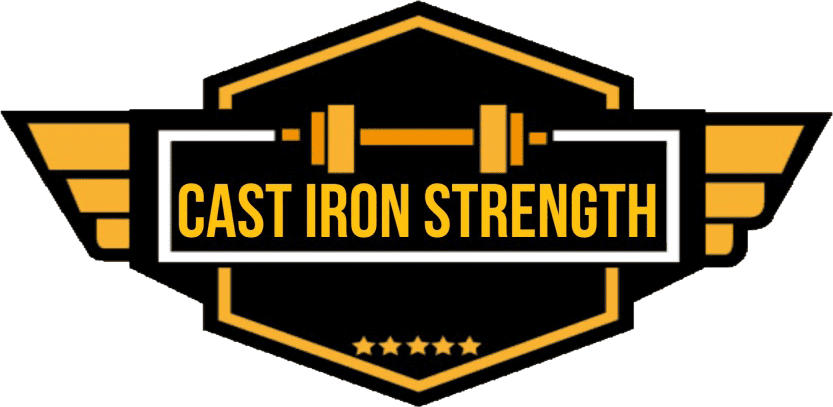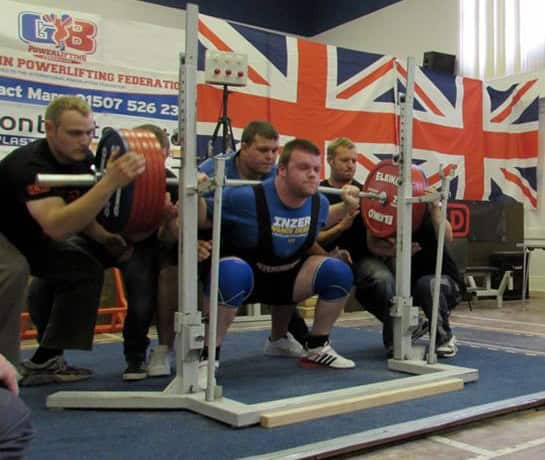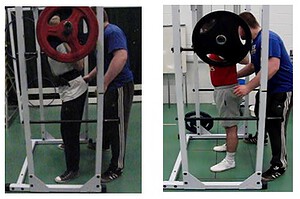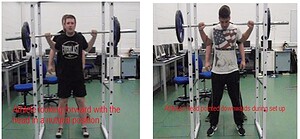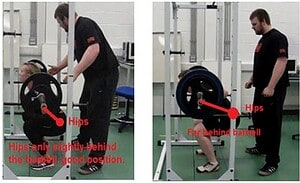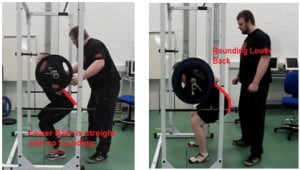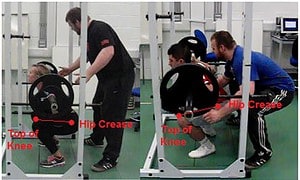Discuss this article on our forums
Preparation Phase Analysis
During this section the bar is un-racked and the lifter steps back and is now standing in the starting position before the decent (eccentric) phase of the lift. Several technical errors were highlighted in this phase of performance; many being common among the athletes assessed.
Chest and Upper-Back Bracing
A common error found was that athletes did not push their chest out in order to brace the upper-back. This would stop the chest falling down and the upper back folding or falling downward.
Figure 1 + 2: The athlete (left) has braced the upper-back and the chest is being pushed out. It can be seen that the athlete has not braced the upper-back and is not pushing the chest out causing a mild forward tilt.
Arm Positioning
Another error is one which, again, the vast majority of participants committed. The elbow position of the athlete is being positioned behind the barbell as opposed to underneath the barbell.
Figure 3 + 4: The elbows of the athlete (left) are underneath the barbell and are a demonstration of correct form. Opposed to figure 4 (right), the elbows of the lifter is behind the barbell.
Head Position
The final error to be seen during the preparation phase of the lift is the head position of the athlete.
Figure 5 + 6: The head (left) is in the neutral position pointing forwards – seen to be the correct form. The head is pointed downwards (right), caused by the back rounding and not bracing the upper-back. This can be seen as poor form.
Action Phase Analysis
This phase involves descending eccentrically to the bottom position of the squat prior to the athlete attempting to return weight back up to the starting position.
Feet and Ankle Position
The heels of the athlete raise off the floor the lower the athlete goes in the squatting position causing the ankles to roll.
Figure 7: This shows the heel raising off the ground and the ankle beginning to roll inwards.
Hips position
The hips being positioned too far behind the barbell was another problem for the athletes, the hips should ideally be underneath the barbell or very slightly behind the barbell.
Figure 8 + 9: Shows the ideal hip position (left) during the squat. Opposed to the ideal position, this image (right) shows the hips in a poor position.
Trunk position
The majority of the athletes leaned forward significantly, during the performance which will put more forces through the lower back. The ideal position involves less of a forward tilt.
Figure 10 + 11: This (left) shows the trunk in an ideal position for the correct execution of the lift. Figure 11 (right) shows is an example of the excessive lean experienced by participants.
Spinal Position
The rounding of the lower back was spotted during the squatting performances, the lower back should be in a straight position throughout the whole lift.
Figure 13 + 14: Figure 13 (left) shows the lower back in an optimal lifting position. Fig. 14 (right) shows the lower back rounding during the action phase
Chest/ Upper-Back Bracing
Many of the athletes did not brace the upper-back and push the chest out during the preparation phase and there for didn’t brace themselves in this phase of the lift either, the implications of this will be discussed further in the discussion section.
Arm Positioning
Again, many athletes had their elbows behind the barbell as opposed to underneath it as they did not perform this part of the technique correctly during the preparation phase.
Head Position
Some of the athletes continued to keep their head pointed downward during the action and eccentric phase of the lift.
Figure 15: This shows the head remaining in the downward position during the action phase.
Recovery Phase Analysis
This phase begins at the bottom position of the squat as the athlete starts to concentrically push the weight back to the starting position.
Every technical error highlighted during the action phase is apparent in the recovery phase with the errors becoming considerably worse.
Knee Position
The knee falling inward toward the athletes other knee was seen during some lifts where the knees should be kept pointing forwards directly above the knee.
Figure 16: This shows the knee falling inward during the squat.
Bar Path
The bar path shows the line in which the barbell has travelled, it should be a smooth line and be straight or slightly sloped. The line in the recovery phase should ideally overlap the line from the action phase. In some performances the bar path was either not a straight, smooth line or the recovery phase did not match the action phase.
Figure 17: This shows the optimum bar path (left) compared to the bar path performed by some of the athletes tested (right).
Powerlifting Rules
Only one rule violation occurred during all participants’ squatting performances regarding the depth of the squat. The rules state that the lifter must squat below parallel so the top of the knee is lower than the hip joint. Some athletes squatted above parallel so this did not happen and is therefore a rule violation.
Figure 18: This image shows the comparison between the correct depth to be performed (left) compared to a depth which would be a rule violation (right).
Discussion
Proper Technical execution of the squat is vital to achieve the maximal possible force production in the squatting movement (Fry, et al.,2003) and to reduce the risk of injury that can occur if optimal technique is not adhered too (Faigenbaum et al., 2009).
There were many technical errors highlighted during this analysis of the results, some errors being much more detrimental to the performance than others. It was noted that many of the errors become progressively worse as each stage progressed throughout the movement. The worst point during the recovery phase of the lift.
One of the most serious errors highlighted was lower back positioning; the lower back was seen to undergo a combination of two errors. The first error in the lower back was the angle the trunk; ideally the trunk would be positioned in a way which allows the back to be upright during the lift or very slightly tilted forward. It was seen during analysis that many of the athletes tilted forward too much during the lift, which can cause a number of issues, being that the shearing forces going through the lower back increase dramatically which increases the risk of a lower back injury. A study by McLaughlin et al., (2013) presents results regarding decreased movement and therefore decreased forces on the back.
In conjunction with lower back positioning, every athlete that had too much forward tilt in the squat also positioned their hips too far behind the bar. The optimal position of the hips is underneath or very slightly behind the barbell, if the hips are slightly behind the barbell a slight forward tilt will occur which is acceptable so long as the tilt is minimal. It would be impossible to squat with the hips far behind the barbell without significant forward tilt occurring as if it was attempted the centre of gravity would be distributed behind the legs as opposed to through them making the athlete unstable and more likely to fall (McLaughlin et al., 1978)
Head position during the analysis pointed downward this has been shown to push the hips behind the barbell and cause increased trunk tilt which can cause many of the lower back positioning issues as discussed above. (Donnelly et al., 2006)
The second error is the rounding of the lower back; this happens when the athlete lifts the weight with the lower back as opposed to with the leg muscles and hips while holding the back still. As the athlete is now lifting with the lower back it is rounding to reduce the lever arm and reduce stress on the lower back muscles somewhat. However this increases the shearing forces in the lower back again and increases the risk of injury such as a slipped disk (Dolan, et al., 1994; McGill and Norman, 1988).
Athletes were seen to have the ‘tuck under’ issue with the lower back, where the lower back was not rounding due to form error but due to the fact that they could not squat down to the required depth without the lower vertebrae rounding underneath. This error is commonly associated with poor flexibility in the hamstrings which causes the lower back to round as the hamstrings are pulling the gluteus and erector spinae out of their proper positioning (Butler, et al.,2010). The tuck under can be the precursor to the two errors in lower back positioning as discussed previously.
In order to keep the lower back in a suitable position for the squat the upper-back must also be held in an ideal position as the position of the upper-back may also compromise technique. The chest falling downward toward the floor will compromise lower back position (Schoenfeld, 2010) and is caused by the aforementioned failings in the upper-back. Very few of the athletes analysed braced their upper-back effectively by tightening the upper-back and pushing the chest out which would consequently put the upper-back in an optimum position to stabilise the load during the squat. While bracing the upper-back it is important to have the elbows positioned underneath the bar as this allows the upper-back to remain in an optimal position. If the elbows are behind the barbell during the lift it will put more strain on the shoulders when the upper-back is forced to stay in the optimal position. The upper-back is then forced into a position of flexion as opposed to holding the upper-back in a state of extension. This error would result in a compromised upper-back position which could transfer to a compromised lower back position and hence effect the ability of the athlete to lift.
The raising of the heels during the squatting movement occurs due to a lack of dorsiflexion flexibility in the ankles (Kasuyama et al., 2009). This causes instability which will result in less weight being able to be lifted and also increases the risk of injury by falling forward. More ankle flexibility would be required to stop this error occurring. Weightlifting shoes have been shown to alleviate this problem as the shoes have a raised heel. The shoes will also assist the athlete in terms of balance as they change the athletes’ position slightly so they can stand more upright; resulting in less shear force in their lower back and the changed position will allow greater knee extensor activation (Sato et al., 2012).
Knee positioning was an issue highlighted through analysis, with the knee falling inward during the squat. This will result in less knee extensor activation reducing the amount of weight able to be lifted and will significantly increase the shear force going through the anterior cruciate ligament and the medial collateral ligament which increases the risk of injury. (Escamilla, 2000)
As a result of many of these technical issues some of the athletes bar path was shown to be erratic as opposed to a smooth straight or slightly curved line. Many of the paths the athletes lifted through were different from the eccentric phase and concentric phase of the lift; it has been shown that the body will most likely find its strongest position during the eccentric phase so the concentric bar path should match the eccentric. Once the athletes improves the technique of the squat bar path should show consequently improve (Winchester et al., 2009).
The only powerlifting rule athletes broke during analysis was the rule regarding squat depth. Athletes squatted to parallel or above when the rules (IPF, 2013) state the athlete must go below parallel; meaning that the hip crease must be below the top of the knee. It would be in the interest of the athletes to squat to the required depth during every repetition preformed so the athlete can develop strength throughout the whole range of movement. Specific training adaptions should can take place allowing the athlete to squat their 1RM below parallel without a significant drop in weight lifted when going below parallel, this will allow the athlete to perform better in competition as they will have trained specifically for the demands of the sport.
Alistair Inglis is a 21 year old powerlifter born and raised in Edinburgh Scotland. He is currently studying for his undergraduate degree in sports science at Edinburgh’s Napier University. Alistair is the current British junior record holder for Squat, Deadlift and Total in the 120+ Class and is the current British Raw Champion in his class. He holds competition bests of 315 kg (693 lbs) Squat, 190 kg (418 lbs) Bench Press and a 330 kg (726 lbs) Deadlift with a 835 kg (1837 lbs) Total.
